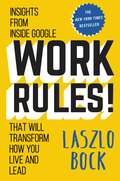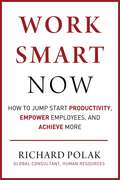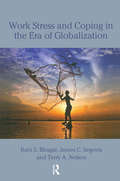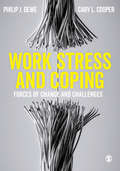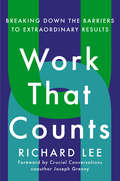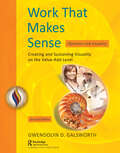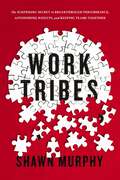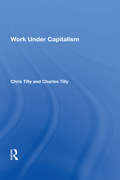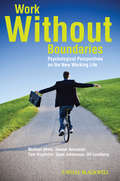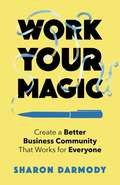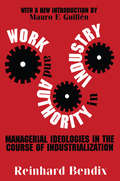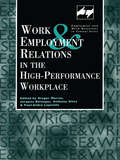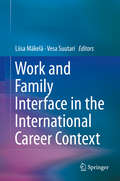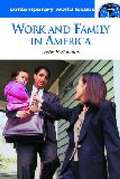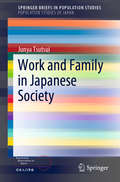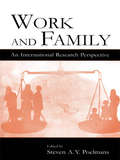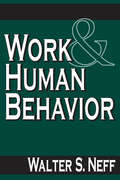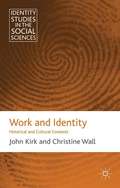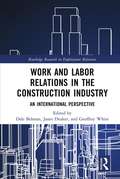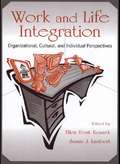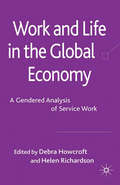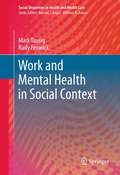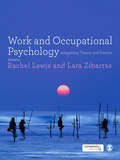- Table View
- List View
Work Rules!: Insights from Inside Google That Will Transform How You Live and Lead
by Laszlo BockNEW YORK TIMES BESTSELLER WALL STREET JOURNAL BESTSELLER From the visionary head of Google's innovative People Operations--a groundbreaking inquiry into the philosophy of work and a blueprint for attracting the most spectacular talent to your business and ensuring the best and brightest succeed. "We spend more time working than doing anything else in life. It's not right that the experience of work should be so demotivating and dehumanizing. " So says Laszlo Bock, head of People Operations at the company that transformed how the world interacts with knowledge. This insight is the heart of WORK RULES!, a compelling and surprisingly playful manifesto with the potential to change how we work and live. Drawing on the latest research in behavioral economics and with a profound grasp of human psychology, Bock also provides teaching examples from a range of industries--including companies that are household names but hideous places to work, and little-known companies that achieve spectacular results by valuing and listening to their employees. Bock takes us inside one of history's most explosively successful businesses to reveal why Google is consistently rated one of the best places to work in the world, distilling 15 years of intensive worker R&D into delightfully counterintuitive principles that are easy to put into action, whether you're a team of one or a team of thousands. Cleaving the knot of conventional management, some lessons from WORK RULES! include: Take away managers' power over employees Learn from your best employees--and your worst Only hire people who are smarter than you are, no matter how long it takes to find them Pay unfairly (it's more fair!) Don't trust your gut: use data to predict and shape the future Default to open: be transparent, and welcome feedback If you're comfortable with the amount of freedom you've given your employees, you haven't gone far enough WORK RULES! shows how to strike a balance between creativity and structure, leading to success you can measure in quality of life as well as market share. Read it to build a better company from within rather than from above; read it to reawaken your joy in what you do.
Work Smart Now: How to Jump Start Productivity, Empower Employees, and Achieve More
by Richard PolakFrom one of the top HR specialists in the world comes this much-needed guide to help people maximize productivity and increase revenue. Whether it&’s in corporate America or in our own living rooms, people are wasting time. From the minute we wake up and check our Facebook page or emails—before we even crawl out of bed—to late at night when we stay up longer than we should, watching our favorite show. There&’s a precise moment that falls between working enough hours to be productive and working too many hours, yielding a diminishing marginal return. The difference between the person able to master this and most Americans that fail miserably at it is quality of life! If one continues to work past this moment, a negative return will ensue, and that negative return produces guilt. It lowers the amount of time for recreational activities and spending time with family. We&’ve siloed productivity to our work life, however; the impact on our personal life is often loss. An alarming 39% of workers in high-tech companies believe they are depressed, as reported by PC Magazine in December 2018. 72% of people who have daily stress and anxiety say it interferes with their lives—anxiety and stress alone have reduced productivity by 56%. More than 80% of people have experienced some form of anxiety, stress, or depression in the workplace. People are spending more time at work than at home or with their loved ones; or, if they are at home, they are working. They are always &“on.&” As a result of this disparity, people are not fully living their lives. And the &“work-life balance&” marketed by some HR consulting firms and employers simply does not work. It&’s all work and no life! Studies have also proven that when people are unhappy in their personal lives or careers, their productivity goes down and everything and everyone around them suffers. This causes a domino effect, which trickles into every area of their lives. Previous generations used to say, &“Work harder,&” but we&’ve now learned we must &“work smarter.&” Polak has practiced and tested his methods in hundreds of opportunities and has been paid millions by the largest corporations in the world to share these tools. He feels that every individual and business should have these tools, and will share them with us here.
Work Stress and Coping in the Era of Globalization
by Rabi S. Bhagat Terry Nelson James SegovisThis book examines the phenomena of how individuals experience work stress and coping in both developed and developing countries in the world. Rabi Bhagat, known for his cross-cultural scholarship in this area, and his co authors, help us recognize the causes and consequences of work stress. They present a systematic, comprehensive review of this topic with plenty of practical insights and case studies examining work stress and coping in the era of globalization. Researchers, practitioners and students in the field of industrial organizational psychology, organizational behavior, and human resources management will find this book of interest.
Work Stress and Coping: Forces of Change and Challenges
by Cary L. Cooper Philip J. DeweWork Stress and Coping the authors provide an historical account of workplace stress, taking a broad approach by integrating the macro forces impacting the micro, and highlighting what the research in the field tells us about the changing nature of work so that individuals and organisations can create more liveable working environments. With an emphasis on the growing influence of globalization, the book explores the forces of change within contemporary societies and assesses how they have fundamentally changed the nature of work and the direction of research into stress and coping. Capturing the history, context, critique and transformation of theory into practice, the authors offer an insight into how managers and businesses have failed, the effects this has had on how work is experienced, the evolution and relevance of existing theories and suggest alternative methods and future directions. Suitable reading for students of HRM, Organisational Behaviour and Occupational Psychology.
Work Stress and Coping: Forces of Change and Challenges
by Dr Cary P. Cooper Dr Philip J. DeweLecturers/Instructors - Request a Free digital inspection copy HERE In Work Stress and Coping the authors provide an historical account of workplace stress, taking a broad approach by integrating the macro forces impacting the micro, and highlighting what the research in the field tells us about the changing nature of work so that individuals and organisations can create more liveable working environments. With an emphasis on the growing influence of globalization, the book explores the forces of change within contemporary societies and assesses how they have fundamentally changed the nature of work and the direction of research into stress and coping. Capturing the history, context, critique and transformation of theory into practice, the authors offer an insight into how managers and businesses have failed, the effects this has had on how work is experienced, the evolution and relevance of existing theories and suggest alternative methods and future directions. Suitable reading for students of HRM, Organisational Behaviour and Occupational Psychology.
Work That Counts: Breaking Down the Barriers to Extraordinary Results
by Richard LeeOne of Silicon Valley's top leadership trainers distills his proven framework that has empowered teams at the world's most innovative companies--from Google and Facebook to Cisco Systems and biotech giant Genentech/Roche--to do the best work of their lives.Richard Lee has worked with thousands of ambitious leaders and their teams, and has found that they all share the same frustration. Whether it's because of communication breakdowns or increasing complexity, people at every level of an organization feel like their results fall short of their expectations--even though they are putting in a lot of effort.Management gurus will tell you that you need to overhaul your entire organization in order to maximize its full potential, but that is simply not true: You only to give your people the tools to succeed inside it.The framework outlined in Work That Counts draws on examples from teams he has worked with at the world's most cutting edge, disruptive companies, and provides practical solutions to the problems that hold people back in nearly every organization. Among other critical skills, you'll learn: • How a team leader can hold team members accountable without micromanaging--and what team members need to do concurrently to earn the team leader's trust. • How to get support for your objectives from other teams, even when they don't report to you or your division or your business unit. • How to partner with others, within your team and on other teams, to achieve the results you want.Work That Counts is a commonsense yet groundbreaking guide, filled with assessments and real-world examples that will empower organizations to make the most of their people and become more than the sum of their parts.
Work That Makes Sense: Operator-Led Visuality, Second Edition
by Gwendolyn D. GalsworthThis book presents the mechanics of implementing visuality on the value-add level known as Work That Makes Sense (WTMS). The step-by-step WTMS process described in this book teaches operators a proven method for translating information deficits into visual solutions that take the struggle out of their day-to-day work. As a result, operators transform their work area into a work environment that speaks—a work environment that, by design, shares vital information in the form of visual devices that help them perform their day-to-day work with precision and completeness. At the heart of this visual conversion approach is an element unique to Galsworth’s paradigm called I-driven that recognizes that operators will pursue self-leadership in the company’s improvement initiatives if they are given the opportunity to learn how to do so. Also recognized is the fact that this can only happen if associates are taught—and given the opportunity to learn and apply a new system of thinking. The author calls this new system visual thinking. This book provides that learning pathway, in detail, supported by hundreds of actual visual solutions, developed by operators who have followed that pathway and become visual thinkers for themselves—I-driven. They become self-leaders, in control of their corner of the world and able and willing to share their strengths with others. In this way, the WTMS process produces a deep and abiding change in the company’s work culture that builds creativity and ownership. As a result, the organization’s leadership framework widens to include operators. When effectively applied the WTMS process detailed in this book produces 15% to 30% improvement in local KPIs, including productivity, on-time delivery, quality, and costs; these figures are documented and presented in the pages of this book. Written for operators, this book includes a wealth of color photographs, the majority of which are visual solutions created by visual thinkers who have lived this process for themselves. All are fully captioned and thoughtfully described. The book also includes twelve tasks that managers implement in support that they seek on the operator level. WTMS teaches that visual devices translate information into exact behavior, embedding and sustaining precision through visual solutions. Precision is built in by the same operators who execute it. This is the heart of an I-driven visual enterprise. Once learned and operationalized, this paradigm allows the organization to take on any new improvement effort. Organizational alignment and teamwork have been redefined and operationalized.
Work Tribes: The Surprising Secret to Breakthrough Performance, Astonishing Results, and Keeping Teams Together
by Shawn MurphyAre you building a typical team… or a high-performance tribe? The motivational power of the desire to belong is the key element for ensuring employee satisfaction and retention, as well as your company’s long-term success.With millions of exhausted employees “living for Friday,” the place we spend most of our time--our workplace--is drudgery. But what happens when leaders revive the workplace by tapping into a hardwired human need? That need, a sense of belonging, can resuscitate employee satisfaction and retention, while also contributing to a company’s long-term success. Employees want more than a job. They want an opportunity to solve essential problems and receive fair pay and benefits. While some companies use slick culture tricks to attract and retain employees, a more meaningful experience can be created by fostering a sense of belonging. How can businesses achieve this? In his new book Work Tribes, Shawn Murphy, CEO of WorqIQ and a sought-after leadership speaker, shows readers how to tap into the motivational pull of belonging. Based on findings from his interviews with leaders and employees at companies such as LinkedIn, The Container Store, Canlis Restaurant, and Barry-Wehmiller, Work Tribes reveals why a human-centered approach is more aligned with the way we work in the twenty-first century. Astonishing outcomes result from making your employees feel welcomed, wanted, and valued--and this book will show you how to transform your team into a unified tribe.
Work Under Capitalism (New Perspectives In Sociology Ser.)
by Chris TillyWork Under Capitalism synthesizes recent institutionalist and Marxist ideas about the organization of production, situating production within a social context. Starting with the transaction rather than the individual, it builds upon a coherent theory and applies it to a wide range of experience, from household labour to transformations of health c
Work Without Boundaries
by Michael Allvin Gunn Johansson Gunnar Aronsson Tom Hagström Ulf LundbergDrawing on more than a decade of inter-disciplinary research, this book provides a comprehensive overview of the available theories, concepts, data and research on new work organizations and the concept of 'work without boundaries'.Explores a concept of work that is not restricted by traditional organizational rules like regular office hours, a single workplace, fixed procedures and limited responsibilityProvides a comprehensive overview of the available theories, concepts, data and research on new work organizationsExamines the shift of power away from organizations to make individuals accountable for their own employability and workDraws on over a decade of original research into 'work without boundaries' in which the authors are key authoritiesBrings together organization theory and work psychology with scholarship from related fields including sociology, social psychology, cognition and psychobiology
Work Your Magic: Create a Better Business Community That Works for Everyone
by Sharon DarmodyThe fallout from the pandemic has yet to be measured, but the way we work will never be the same again. In this accessible, interactive guide, longtime organizational coach and consultant Sharon Darmody reveals what a unique opportunity this has presented to rebuild our working lives from the ground up—to make work work again—and shows readers how to do just that.
Work and Authority in Industry: Managerial Ideologies in the Course of Industrialization
by Richard BendixWork and Authority in Industry analyzes how the entrepreneurial class responded to the challenge of creating, and later managing, an industrial work force in widely differing types of industrial societies: the United States, England, and Russia. Bendix's penetrating re-examination of an aspect of economic history largely taken for granted was first published in 1965. It has become a classic. His central notion, that the behavior of the capitalist class may be more important than the behavior of the working class in determining the course of events, is now widely accepted. The book explores industrialization, management, and ideological appeals; entrepreneurial ideologies in England's early phase of industrialization; entrepreneurial ideologies in eighteenth- and nineteenth-century Russia; the bureaucratization of economic enterprises; and the American experience with -industrialization. This essential text will interest those in the fields of political science, industrial relations, management studies, as well as comparative sociologists and historians.
Work and Employment in the High Performance Workplace (Routledge Studies in Employment and Work Relations in Context)
by Jacques Bélanger Gregor Murray Anthony Giles Paul-André LapointeThere is a general consensus that deep-seated changes are reshaping the way production and work are organized, the way employees, employers and their representatives deal with each other, and the way governments seek to shape society. In this work a group of leading scholars take stock of the evidence and implications of the new workplace. Drawing on examples from a variety of national contexts, they seek to characterize the nature of contemporary workplace change, and assess its implications for the organization of work for workers, for employment relations and for public policy.
Work and Family Interface in the International Career Context
by Liisa Mäkelä Vesa SuutariThis book focuses on the interface of work and personal life of international professionals. The globalization of business has led to an increasing number of people who work in international roles either through working abroad on different kinds of assignments or through international travelling. This book provides novel knowledge on the topic from different perspectives, highlighting not only the inherent challenges but also the positive side of working in a modern globalized world. Moreover, the book contributes by bringing together international professionals' own experiences, family members' experiences, organizational aspects and new theoretical discussions and models. The book covers several different perspectives on the work and personal life interface offering insights on the areas like adjustment, social support, dual-career issues and organizational practices. The book examines the situations of several different types of international employee such as organizational expatriates, self-initiated expatriates and international business travellers. The new interesting research evidence is provided from various country contexts from North America, Europe and Asia by researchers around the world.
Work and Family in America: A Reference Handbook
by Mildred Vasan Leslie F. StebbinsThis reference provides students, researchers, human resource professionals, and activists with a balanced and detailed overview of the field of work-family. It reviews research in the field, chronicles work-family issues since 1800, and provides biographies of researchers currently active in the field. Important legislation and cases are reviewed, with particular emphasis on employment laws affecting women, and statistics are provided on work-family trends nationally and internationally. The reference includes descriptions and contact information for public and private organizations, annotated bibliographies of print, video, and Internet resources, and a glossary. The author teachers sociology and women's studies at Brandeis University.
Work and Family in Japanese Society (SpringerBriefs in Population Studies)
by Junya TsutsuiThis book provides a systematic framework for interpreting the fertility decline in Japan. It situates the change in fertility rates in a broader context, such as family life and working customs. The basic argument it puts forward is that Japan has failed to establish a “dual-earner” society: women still face the trade-off between having a career or starting a family, which has led to an extremely low fertility rate in Japanese society. Further to this rather common explanation, which could also be applied to other low-fertility societies such as Germany and Italy, the author presents an original view. Japan has had its own momentum in holding on to its strong “men as breadwinners and women as housekeepers” model by creating a unique regime, namely, a Japanese model of a welfare society. This regime places special emphasis on the welfare provided by private companies and family members instead of by the government. Private firms are expected to secure men’s jobs and income to the greatest extent, taking advantage of Japanese employment customs. On the other hand, women are expected to provide care for their family members. The book argues that the familialist orientation is still dominant in Japan and is repeatedly reinforced in the policy context.
Work and Family: An International Research Perspective (Applied Psychology Series)
by Steven A. Y. PoelmansThe entrance of women into managerial positions in significant numbers brings work and family issues to center stage, shifting the spotlight from issues of entry and equality of access to the consideration of the work-family conflicts and the difficulties posed on female managers. Looking at new approaches to enhance the work-family interface individually and in the firm, Work and Family: An International Research Perspective:*provides an overview on the antecedents of work-family conflict and the major consequences of work-family conflict, for well-being, productivity, and the strength of the relationship with the firm;*discusses the migrant's work and family experiences in terms of the demands, opportunities, and constraints they face and the role of work-family culture in reconciling the demands of work and family in organizations;*presents descriptive data concerning the linkages between work-family pressure and several known correlates and the differences in reported levels of each of these variables;*explores the work-life balance challenges and opportunities created by global assignments;*examines the work-family interface of the Western model and urban sub-saharan Africa;*emphasizes the importance of organizational change to the dynamics of work-family policies; and*highlights the progress in moving the field toward an open-systems perspective.Written by well-known contributors, this book offers international research in order to test the models mostly developed in the United States. In addition, it develops new models to capture the complexity and diversity of work-family experiences around the globe and explores cross-cultural topics.
Work and Human Behavior
by Walter NeffWork is a many-sided human enterprise that has been written about from a great many different points of view, representing almost every field of knowledge and almost every level of our social structure. Merely to identify these points of view is an impressive task. The subject of work has been written about by theologians and philosophers, by poets and novelists, by historians, economists, and sociologists, by biologists and naturalists, by politicians, by essayists and journalists. It has been described as both a blessing and a curse, as the chief means through which man has developed a high culture, and as a ravager of our natural environment. Following the preface, and an introductory chapter on the scope of the problem of work the title is divided up into four main sections, which include: The Nature of Work, Clinical Issues, Work and Mental Health, and Some Contemporary Problems Since the first two editions, new issues have arisen that are currently leading to a certain amount of public uproar. The first issue concerns the sources of worker productivity prompted by the current decline of preeminence of United States industry both in the world market and in certain aspects of our internal market. The second issue involves the complex relations between work and mental health, with work being viewed, on one hand, as a factor in the generation of insecurity and mental illness and, from another, as a factor in the treatment of the severe mental disorders. While much of the current published material on these two issues is characterized more by heat than by enlightenment, the third edition includes new chapters in these widely debated areas.
Work and Identity
by John Kirk Christine WallThis book presents an accessible and fascinating account of theoretical debates around identity and work, recent empirical trends and methodological arguments concerning the role of oral testimony and its interpretation. Focusing on three occupational sectors in particular teachers, bank workers and the railway industry it also presents an argument that is both more general than this and theoretically and analytically wide-ranging. The book explores some important questions: how are workers, both in the past and the present juncture, socialised into work cultures? What are the cultural and structural differences with regard the world of work across class, gender, and generation? What are the historical conditions of which these differences play a part? How is the idea of work found in a range of representations, from artistic production to sociological discourse expressed and explored? The development of concepts such as 'structures of feeling' and affect, and the weaving in of historical and visual material, make the book important to a wide range of readers including ethnographers, cultural sociologists and narrative researchers. In turn, this book offers an authoritative and sophisticated summary and analysis of work and identity and is an important intervention into mainstream sociology concerns.
Work and Labor Relations in the Construction Industry: An International Perspective (Routledge Research in Employment Relations)
by Dale BelmanThe need for a skilled, motivated and effective workforce is fundamental to the creation of the built environment across the world. Known in so many places for a tendency to informal and casual working practices, for the sometimes abusive use of migrant labor, for gendered male employment and for a neglect of the essentials of health and safety, the industry, its managers and its workforce face multiple challenges. This book brings an international lens to address those challenges, looking particularly at the diverse ways in which answers have been found to manage safe and productive employment practices and effective employment relations within the framework of client demands for timely and cost-effective project completions. Whilst context, history and contractual frameworks may all militate against a careful attention to human resource issues this makes them even more deserving of attention. Work and Labor Relations in Construction aims to share understanding of best practice in the industries associated with construction and related activities, recognizing that effective work organization and good standards of employee relations will vary from one location to another. It acknowledges the real difficulties encountered by workers in parts of the developing world and the quest for improvement and awareness of some of the worst hazards and current practices. This book is both critical and analytical in approach and seeks to alert readers to the need for change. Aimed at addressing practical issues within the construction industry from a theoretical and empirical standpoint, it will be of value to those interested in the built environment, employment relations and human resource management.
Work and Leisure
by A. J. Veal John T. HaworthGlobalization, economic development and changes in social environments have put the relationships between work, leisure, social structure and quality of life under the spotlight. Profound transformations in the nature and organization of work are occurring, with potentially far-reaching social and economic consequences. Increasingly, organizations demand greater flexibility from their workforces and are introducing new technologies and practices in response to global competitive pressures. At the same time many employees are experiencing long working hours, increasing workloads and job insecurity, along with the challenge of balancing work and domestic responsibilities. These changes threaten long-term gain in leisure time while, simultaneously, the leisure environment is also changing radically, as we see increasing commercialization and professionalization of leisure services and experiences, the influence of the Internet, the rise of gambling and the decline of community-based activity. Exploring all of these issues, this book brings together specially commissioned chapters from international experts in a wide range of disciplines concerned with work, leisure and well-being. Each author takes stock of the current position, identifies core practical and theoretical issues and discusses possible future trends in order to provide an invaluable resource for all policy-makers, educators, employers and researchers in the field.
Work and Life Integration: Organizational, Cultural, and Individual Perspectives (Applied Psychology Series)
by Ellen Ernst Kossek Susan J. LambertWork-family researchers have had much success in encouraging both organizations and individuals to recognize the importance of achieving greater balance in life. Work and Life Integration addresses the intersect between work, life, and family in new and interesting ways. It discusses current challenges in dealing with work-life integration issues and sets the stage for future research agendas. The book enlightens the research community and informs the public debates on how workplaces can be made more family sensitive by providing contributions from psychologists, sociologists, and economists who have not shied away from asserting the policy implications of their findings.This text appeals to both practitioners and academics interested in seeking ways to create meaningful lives.
Work and Life in the Global Economy
by Debra Howcroft Helen RichardsonThis book aims to explore the social and cultural issues within the economic changes that have given rise to service work. Written by specialists in their respective fields, this book draws together authors from interdisciplinary areas that are carrying out significant research into gender and service work within an international context.
Work and Mental Health in Social Context
by Mark Tausig Rudy FenwickAnyone who has ever had a job has probably experienced work-related stress at some point or another. For many workers, however, job-related stress is experienced every day and reaches more extreme levels. Four in ten American workers say that their jobs are "very" or "extremely" stressful. Job stress is recognized as an epidemic in the workplace, and its economic and health care costs are staggering: by some estimates over $ 1 billion per year in lost productivity, absenteeism and worker turnover, and at least that much in treating its health effects, ranging from anxiety and psychological depression to cardiovascular disease and hypertension. Why are so many American workers so stressed out by their jobs? Many psychologists say stress is the result of a mismatch between the characteristics of a job and the personality of the worker. Many management consultants propose reducing stress by "redesigning" jobs and developing better individual strategies for "coping" with their stress. But, these explanations are not the whole story. They don't explain why some jobs and some occupations are more stressful than other jobs and occupations, regardless of the personalities and "coping strategies" of individual workers. Why do auto assembly line workers and air traffic controllers report more job stress than university professors, self-employed business owners, or corporate managers (yes, managers!)? The authors of Work and Mental Health in Social Context take a different approach to understanding the causes of job stress. Job stress is systematically created by the characteristics of the jobs themselves: by the workers' occupation, the organizations in which they work, their placements in different labor markets, and by broader social, economic and institutional structures, processes and events. And disparities in job stress are systematically determined in much the same way as are other disparities in health, income, and mobility opportunities. In taking this approach, the authors draw on the observations and insights from a diverse field of sociological and economic theories and research. These go back to the nineteenth century writings of Marx, Weber and Durkheim on the relationship between work and well-being. They also include the more contemporary work in organizational sociology, structural labor market research from sociology and economics, research on unemployment and economic cycles, and research on institutional environments. This has allowed the authors to develop a unified framework that extends sociological models of income inequality and "status" attainment (or allocation) to the explanation of non-economic, health-related outcomes of work. Using a multi-level structural model, this timely and comprehensive volume explores what is stressful about work, and why; specifically address these and questions and more: -What characteristics of jobs are the most stressful; what characteristics reduce stress? -Why do work organizations structure some jobs to be highly stressful and some jobs to be much less stressful? Is work in a bureaucracy really more stressful? -How is occupational "status" occupational "power" and "authority" related to the stressfulness of work? -How does the "segmentation" of labor markets by occupation, industry, race, gender, and citizenship maintain disparities in job stress? - Why is unemployment stressful to workers who don't lose their jobs? -How do public policies on employment status, collective bargaining, overtime affect job stress? -Is work in the current "Post (neo) Fordist" era of work more or less stressful than work during the "Fordist" era? In addition to providing a new way to understand the sociological causes of job stress and mental health, the model that the authors provide has broad applications to further study of this important area of research. This volume will be of key interest to sociologists and other researchers studying social stratification, public health, political economy, institutional and organizational theory.
Work and Occupational Psychology: Integrating Theory and Practice
by Rachel Lewis Lara ZibarrasWork and Occupational Psychology is the ideal companion for any student of the field, whether they are studying for a postgraduate qualification with a view to working in OP, or taking the subject as part of a wider degree programme at any level.<P><P> Written by a team of experts and with contributions from seminal academics and leading practitioners, this text provides the concise link between theoretical learning and the key practical skills needed to increase your grades and your employability.<P> Features of this book include:<P> - Structured around the eight core areas of Occupational Psychology to ensure a rounded overview and enables students to dip in and out of the text<P> - Assumes no prior knowledge of the subject making it ideal for anyone studying Occupational Psychology for the first time<P> - Provides a contemporary and future-facing account of the field, including cutting edge research and reflections on future of Occupational Psychology<P> - Reflects the realities of a global workplace through discussion of international and cross-cultural issues and a range of international case studies<P> - Engages critically with the subject to encourage analytical thinking<P> - Comes with a range of accessible in-text and online learning features including essay/exam questions, access to full text SAGE journal articles, podcasts and a glossary.<P> Visit the Companion Website at www.sagepub.co.uk/zibarras
